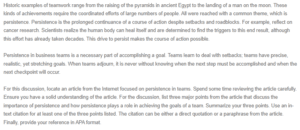Persistence on Teams – The Secrets of Great Teamwork
Achieving any goal goes beyond just knowing what to do. In the workplace, every team knows what is required of them and how they can achieve that, but achieving goals is a different issue altogether. The key to achieving targets lies in following plans every day until the desired results are achieved.
Personal adherence is crucial to achieving team goals. Adherence is the ability to stick with one’s goals until they are achieved, no matter how long it takes. Since team performance relies on individual personal members’ achievements, one must stick to their personal goals. There are three key components that determine adherence in teams; focus, passion, and competence. Team leaders should create a working environment that facilitates members to focus. Also, team members ought to feel like part of the organization to work passionately. Finally, leaders must ensure they select competent individuals for specific tasks. Team leaders and members must adhere to collective and individual plans if they are to achieve team goals.
Another enabling factor for team persistence is a sense of direction. Most teams are motivated by the existence of a clear target, which in turn energizes and orients teams to do the right thing. Teams may not perform effectively if they lack explicit goals they are working towards. Such goals must be challenging to keep the team motivated but not so challenging to keep the team dispirited. Goals must also be consequential, such that performers will get promotions, bonuses, and other benefits.
Besides, teams ought to have a shared mindset to remain persistent. In an age of digital communication coupled with diversity and team membership changes, there is a likelihood of ‘us vs. them’ situations. To correct this, team leaders ought to cultivate a culture of understanding and common identity amid the differences. Regular face-to-face meetings in place of digital communication will foster a sense of identity and understanding among team members.
References
Haas, M., & Mortensen, M. (2016). The Secrets of Great Teamwork. Retrieved 4 November 2021, from https://hbr.org/2016/06/the-secrets-of-great-teamwork
ORDER A PLAGIARISM-FREE PAPER HERE
We’ll write everything from scratch
Question 

The Secrets of Great Teamwork
Historic examples of teamwork range from the raising of the pyramids in ancient Egypt to the landing of a man on the moon. These kinds of achievements require the coordinated efforts of large numbers of people. All were reached with a common theme, which is persistence. Persistence is the prolonged continuance of a course of action despite setbacks and roadblocks. For example, reflect on cancer research. Scientists realize the human body can heal itself and are determined to find the triggers to this end result, although this effort has already taken decades. This drive to persist makes the course of action possible.
Persistence in business teams is a necessary part of accomplishing a goal. Teams learn to deal with setbacks; teams have precise, realistic, yet stretching goals. When teams adjourn, it is never without knowing when the next step must be accomplished and when the next checkpoint will occur.
For this discussion, locate an article from the Internet focused on persistence in teams. Spend some time reviewing the article carefully. Ensure you have a solid understanding of the article. For the discussion, list three major points from the article that discuss the importance of persistence and how persistence plays a role in achieving the goals of a team. Summarize your three points. Use an in-text citation for at least one of the three points listed. The citation can be either a direct quotation or a paraphrase from the article. Finally, provide your reference in APA format.